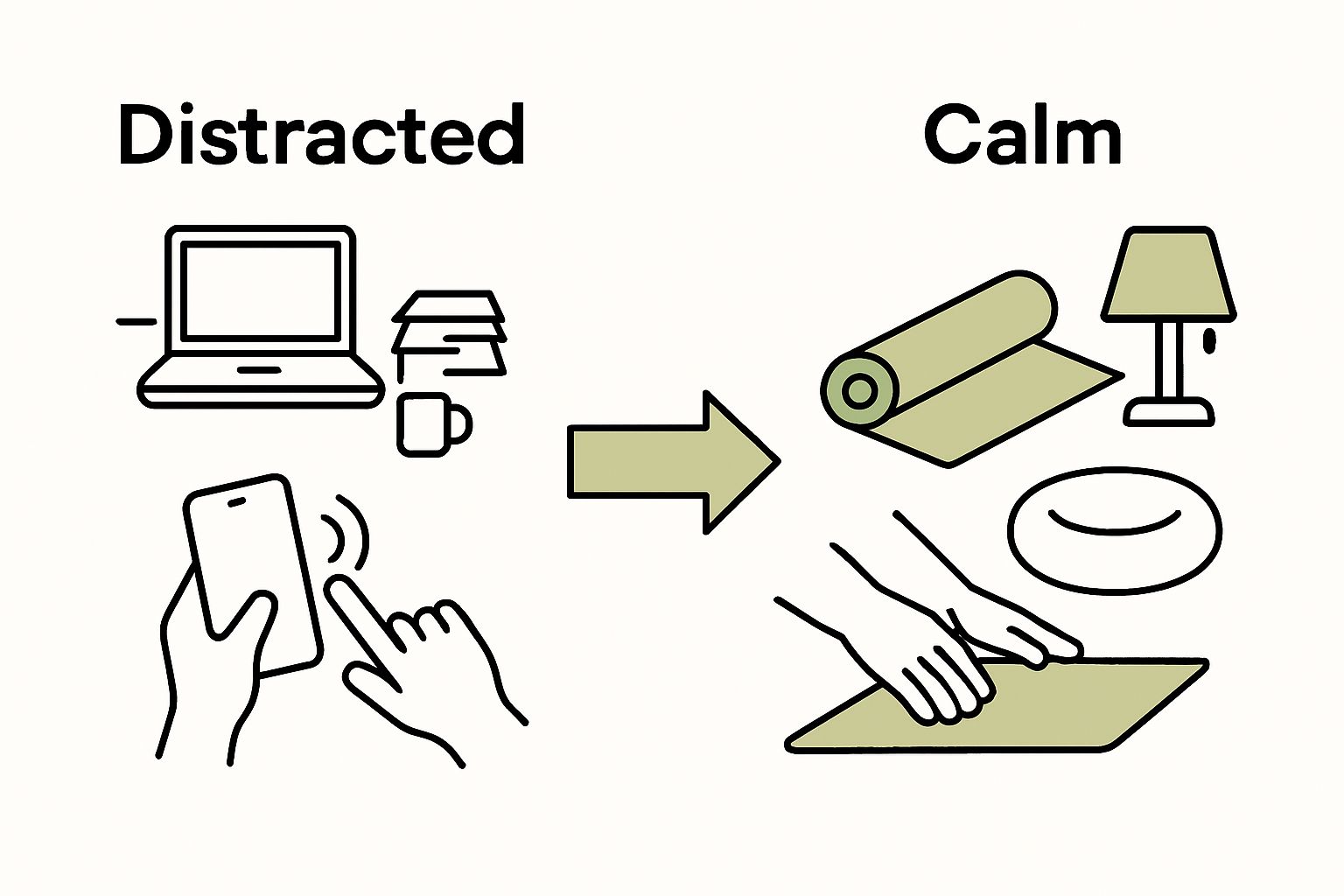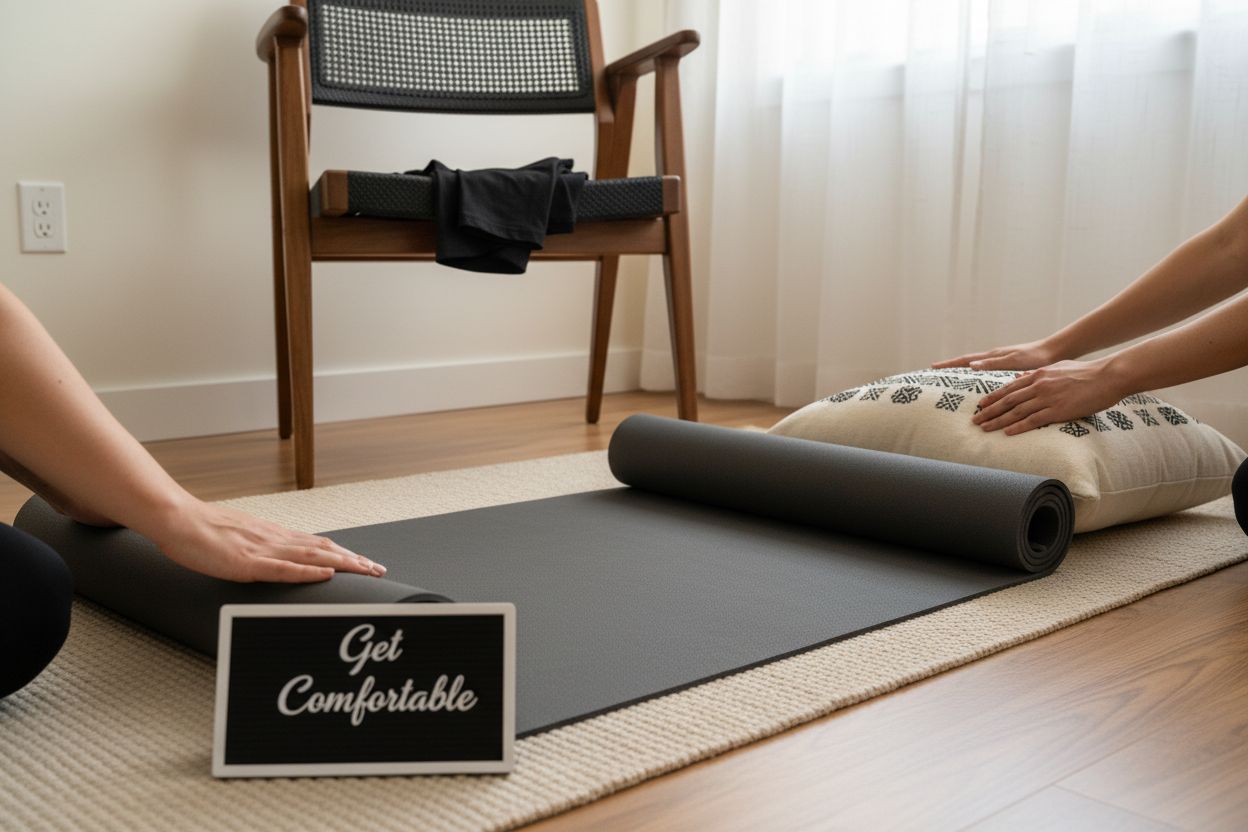Body scan meditation often promises deeper relaxation and better focus, and people have been practicing it to quiet the mind for years. Yet most guides fail to mention one surprising detail. Even subtle sources of electromagnetic interference in your home can disrupt your session without you realizing it. This single factor can decide whether your meditation leaves you feeling totally refreshed or just frustrated, all based on what is quietly buzzing around you.
Table of Contents
- Step 1: Find A Quiet Space Free From Distractions
- Step 2: Set Your Intentions For The Practice
- Step 3: Get Comfortable In A Relaxed Position
- Step 4: Begin The Body Scan From Head To Toe
- Step 5: Acknowledge Sensations And Release Tension
- Step 6: Reflect On Your Experience After The Session
Quick Summary
| Key Point | Explanation |
|---|---|
| 1. Create a Distraction-Free Environment | Choose a quiet, calming space free from interruptions to enhance your meditation experience. Consider rooms where external noise is minimal and energy is soothing. |
| 2. Set Positive Intentions for Your Practice | Establish clear, compassionate intentions that guide your awareness during meditation. This approach fosters curiosity and enhances emotional regulation. |
| 3. Find a Comfortable Position | Choose a meditation posture that balances relaxation and alertness, allowing your body to feel supported and unrestricted for effective practice. |
| 4. Acknowledge and Release Sensations | Engage with bodily sensations without judgment, breathing into areas of tension to facilitate release and deepen your inner exploration. |
| 5. Reflect on Your Experience Post-Meditation | After meditating, take time to process your experience, noting lingering sensations and insights to deepen your self-awareness and emotional understanding. |
Step 1: Find a Quiet Space Free from Distractions
Creating the optimal environment for body scan meditation is your first critical step toward achieving deep relaxation and heightened bodily awareness. Selecting the right space can dramatically transform your meditation experience, allowing you to disconnect from external chaos and tune into your internal landscape.
Your meditation sanctuary needs to be more than just physically quiet - it should feel emotionally safe and energetically calm. Think about spaces in your home where electromagnetic interference is minimal and external noise can be controlled. Bedrooms, home offices, or dedicated meditation corners often work best. Avoid areas near wireless routers, smart devices, or high-traffic zones that could interrupt your practice.
The goal is to create an environment that signals to your nervous system that it’s time to relax and turn inward.
 According to UC Davis Health Wellness Program, a distraction-free setting is crucial for effective mindfulness practices. Consider these key preparation strategies:
According to UC Davis Health Wellness Program, a distraction-free setting is crucial for effective mindfulness practices. Consider these key preparation strategies:
- Choose a space where you won’t be interrupted by family members, pets, or electronic notifications
- Use noise-canceling headphones if complete silence isn’t possible
- Ensure room temperature is comfortable - not too hot or cold
- Have a supportive surface like a yoga mat, cushion, or comfortable chair ready
Some practitioners prefer dimmed lighting or soft natural light to enhance their meditative state. If possible, position yourself away from windows with direct sunlight or street noise. Your physical positioning matters as much as the space itself. Sit or lie down in a posture that feels natural and sustainable for the duration of your body scan meditation.
To help you select and optimize your meditation space, here is a checklist table summarizing environmental factors and preparation tips for your body scan session.
| Checklist Item | Purpose | Recommendation |
|---|---|---|
| Noise Level | Minimize external sound disturbances | Choose quietest available space |
| Electromagnetic Interference | Reduce EMF exposure | Distance from routers/devices |
| Physical Comfort | Support body posture for relaxation | Yoga mat, cushion, or soft chair |
| Temperature | Maintain comfort to avoid distraction | Adjust heating/cooling as needed |
| Lighting | Enhance calmness and mindfulness | Use soft/dim/natural lighting |
| Distraction Control | Prevent interruptions from people or pets | Inform others, close doors |
| Devices and Notifications | Avoid alerts and distractions | Silence/turn off electronics |
Remember that perfect conditions are not mandatory. While an ideal space is helpful, your commitment and focus matter more than creating a flawless environment. Start where you are, use what you have, and gradually refine your meditation setup as you develop your practice. The most important element is your intention and willingness to explore your inner landscape through body scan meditation.
Here is an at-a-glance guide to the body scan meditation steps, summarizing the focus, intention, and main activity involved at each stage.
| Step Number | Step Name | Main Focus | Key Intention | Main Activity |
|---|---|---|---|---|
| 1 | Find a Quiet Space | Environment | Minimize distractions | Prepare calming, safe setting |
| 2 | Set Your Intentions | Mindset | Cultivate curiosity and compassion | Reflection and statement of purpose |
| 3 | Get Comfortable | Physical posture | Facilitate relaxation and alertness | Find and adjust body position |
| 4 | Begin the Body Scan | Bodily regions | Foster awareness and presence | Systematic head-to-toe attention |
| 5 | Acknowledge & Release Sensations | Sensations and tension | Practice non-judgment and letting go | Observe, breathe, and release tension |
| 6 | Reflect on Experience | Integration and awareness | Deepen self-understanding | Post-session quiet and observation |
Step 2: Set Your Intentions for the Practice
Setting clear intentions transforms body scan meditation from a passive activity into a powerful personal growth tool. Your intention serves as an energetic compass, guiding your awareness and creating a purposeful container for your practice. Unlike rigid goals, intentions are fluid, compassionate commitments to yourself that invite exploration and self-understanding.
Intentions are not about achieving a specific outcome, but about cultivating a mindset of curiosity, acceptance, and gentle awareness. Before beginning your body scan meditation, take a moment to reflect on why you are practicing. Are you seeking stress relief, emotional healing, physical relaxation, or deeper self-connection? Your intention might be as simple as “I am here to listen to my body” or “I will approach myself with kindness and non-judgmental awareness.”
According to National Institutes of Health research, intentionality can significantly enhance mindfulness practice by supporting sustained attention and emotional regulation. When setting your intention, consider these guiding principles:
- Choose an intention that resonates with your current emotional and physical state
- Frame your intention positively and in the present moment
- Keep your intention compassionate and open-ended
- Allow your intention to be flexible and adaptive
Practical intention-setting involves a brief internal dialogue or quiet reflection before you begin. Close your eyes, take a few deep breaths, and ask yourself what you truly need in this moment. Perhaps you need healing, understanding, or simply permission to rest. Your intention might emerge as a gentle statement, a feeling, or even a subtle intuition.
Electromagnetic sensitivity and body awareness can also inform your intention. If you are someone conscious of environmental energy fields, your intention might include creating a protective energetic boundary or supporting your body’s natural resilience. This approach acknowledges the complex interplay between your inner landscape and external environmental influences, transforming body scan meditation into a holistic practice of self-care and energetic protection.
Step 3: Get Comfortable in a Relaxed Position
Finding the right physical position is crucial for an effective body scan meditation, serving as the foundation for deep relaxation and internal exploration. Your body’s comfort directly impacts your ability to maintain focus and release tension, creating a supportive environment for mindful awareness.
The ideal meditation posture is one that balances alertness with complete relaxation. You have multiple options depending on your physical condition and personal preference. Lying down on a yoga mat, soft carpet, or bed works wonderfully for many practitioners, allowing complete body support. Alternatively, sitting in a chair with a supportive back or on a cushion with crossed legs can be equally effective. The key is maintaining a position that allows your body to feel grounded yet unrestricted.
According to Harvard Medical School’s Mindfulness Research, physical positioning plays a critical role in meditation effectiveness. Consider these guidelines for optimal positioning:
- Keep your spine relatively straight but not rigidly tense
- Ensure your neck and shoulders are relaxed
- Allow your hands to rest comfortably on your lap or beside your body
- Use supportive props like cushions, blankets, or rolled towels to enhance comfort
For individuals sensitive to electromagnetic frequencies, positioning becomes even more strategic. Choose a location away from electronic devices, and consider using grounding mats or natural fiber surfaces that can help minimize environmental energy interference. Electromagnetic sensitivity can impact your body’s relaxation response, so creating a energetically neutral space supports deeper meditation.
Pay attention to subtle physical signals as you settle into your position. If you feel any sharp pain or significant discomfort, make gentle adjustments. The goal is not perfection but creating a sustainable, nurturing environment for your body scan practice.
 Your position should feel like a supportive container that allows your consciousness to turn inward, releasing external tensions and preparing for a journey of deep internal exploration.
Your position should feel like a supportive container that allows your consciousness to turn inward, releasing external tensions and preparing for a journey of deep internal exploration.
Step 4: Begin the Body Scan from Head to Toe
The systematic journey through your body begins with a gentle, purposeful awareness that transforms internal exploration into a profound healing experience. Starting from your head and progressively moving downward allows you to create a deliberate, meditative pathway of consciousness that connects every part of your physical being.
Your initial focus will be on the crown of your head, inviting soft, non-judgmental attention to this area. Close your eyes and imagine a warm, healing light gently illuminating the top of your skull. Notice any sensations without attempting to change them - perhaps a slight tingling, a sense of pressure, or complete neutrality. Breathe naturally, allowing each exhale to help release any tension you might discover.
According to Mindful.org’s meditation guidelines, the progressive scanning technique helps cultivate present-moment awareness and deep internal connection. As you move your attention downward, transition through these body regions with patience:
- Forehead and temples
- Eyes and surrounding facial muscles
- Jaw and cheeks
- Neck and throat area
- Shoulders and upper back
- Chest and upper torso
- Arms and hands
- Abdomen and lower back
- Hips and pelvis
- Legs
- Feet and toes
Electromagnetic sensitivity adds an intriguing layer to body scanning. For individuals attuned to environmental energy fields, this practice becomes more than relaxation - it’s an opportunity to observe how your body responds to and processes subtle energetic influences. Pay attention to any unique sensations that might indicate your body’s interaction with surrounding electromagnetic frequencies.
Remember that body scanning is not about achieving a specific state but about cultivating curious, compassionate awareness. Some moments will feel intense, others completely neutral. Your only task is to observe without judgment, allowing each bodily region to reveal its current state of being.
Approach this exploration as a gentle witness, creating space for whatever sensations emerge during your meditative journey.
Step 5: Acknowledge Sensations and Release Tension
Acknowledging bodily sensations without judgment is a transformative practice that allows you to develop a profound connection with your physical experience. This step moves beyond mere observation, inviting you to create a compassionate dialogue with the subtle and sometimes intense sensations that emerge during your body scan meditation.
Tension is not something to fight or eliminate, but rather a communication system your body uses to signal its current state. When you encounter areas of tightness or discomfort, approach them with curiosity and gentle awareness. Imagine your breath as a soft, healing light that can soften and dissolve these areas of constriction. Breathe into the sensation, not to change it, but to be fully present with it.
According to Positive Psychology research, recognizing and releasing tension can significantly reduce stress and promote overall well-being. As you scan through different body regions, you might encounter a range of sensations:
- Warmth or coolness
- Tingling or pulsing
- Pressure or heaviness
- Subtle vibrations
- Areas of complete neutrality
- Localized areas of tension or discomfort
For individuals sensitive to electromagnetic frequencies, this step becomes especially intriguing. Some practitioners report feeling energetic blockages or unusual sensations that might correlate with environmental electromagnetic influences. Pay attention to how different body regions feel in relation to your surroundings. Your body might be communicating subtle information about energy fields that extend beyond physical sensations.
The key is maintaining a non-reactive, observational stance. When tension surfaces, acknowledge its presence without attaching a story or judgment. Visualize the sensation as a cloud passing through the sky of your awareness - present, but not permanent. Your breath becomes a gentle tool of acknowledgment, creating space around the sensation and allowing it to naturally shift and dissolve. This practice transforms body scan meditation from a mere relaxation technique into a profound journey of self-discovery and energetic awareness.
Step 6: Reflect on Your Experience After the Session
Reflection transforms a body scan meditation from a passive practice into a powerful tool for personal growth and self-understanding. The moments after your meditation are just as crucial as the practice itself, offering a bridge between your inner experience and daily life awareness.
Take a few moments to sit quietly after completing your body scan, allowing the residual sensations and insights to gently settle. Do not rush to immediately jump back into your routine. Instead, create a soft landing space for your consciousness to integrate the experience. Notice how your body feels - are there lingering sensations of relaxation, tingling, or a subtle energetic shift?
According to Harvard Medical School’s Mindfulness Research, processing meditation experiences can significantly enhance emotional regulation and self-awareness. Consider documenting your observations through these reflection approaches:
- Write brief notes about physical sensations
- Record any emotional states that emerged
- Observe any insights about your body’s energy
- Note areas of tension or unusual sensations
- Track your overall feeling of groundedness
For individuals sensitive to electromagnetic frequencies, this reflection becomes particularly fascinating. Pay attention to how your body feels in relation to environmental energies. Did you notice any unique sensations that might correlate with electromagnetic interference? Some practitioners report heightened awareness of subtle energy shifts during and after body scan meditation.
Remember that reflection is not about judgment or analysis, but curious observation. Approach your post-meditation insights with the same compassionate awareness you cultivated during the body scan. Some sessions will feel profound, others more neutral - and both are equally valuable. The goal is developing a deeper, more intuitive relationship with your body’s intricate communication system, recognizing that each meditation is a unique journey of self-discovery.
Elevate Your Body Scan Meditation by Protecting Your Energy
Deep relaxation and heightened awareness are the cornerstones of successful body scan meditation. In your practice, you are encouraged to create a tranquil space and become genuinely attuned to your body’s sensations. Yet, many people experience lingering tension or unexplained restlessness during meditation sessions. One often overlooked factor is exposure to electromagnetic field (EMF) radiation from everyday devices like phones, WiFi routers, and wireless headphones. The article discusses electromagnetic sensitivity as a real barrier to body awareness and deep internal calm. If you have ever felt distracted, agitated, or tense even in a quiet environment, EMF radiation could be impacting your physical relaxation and meditation outcome.
Discover how our ORB MiCRO collection can help create an energetically clean space for your mindfulness journey. Our products are designed to safeguard your body from the deleterious effects of EMF, supporting heart, blood, body strength, and water structure as proven by our tests. See the real benefits of practicing body scan meditation in a truly protected environment.

Ready to transform your meditation practice and protect your wellbeing? Visit our main website or explore all Omnia products to choose your EMF protection solution. Give your mind and body the chance to experience real relaxation. Make the shift today for deeper peace and awareness.
Frequently Asked Questions
What is body scan meditation?
Body scan meditation is a mindfulness practice that involves systematically focusing your attention on different parts of your body, noticing sensations, and releasing tension. It promotes relaxation and enhances bodily awareness.
How do I prepare for a body scan meditation session?
To prepare for body scan meditation, find a quiet space free from distractions, set a clear intention for your practice, and choose a comfortable position, whether sitting or lying down.
What are the benefits of practicing body scan meditation?
Practicing body scan meditation can lead to reduced stress, improved emotional regulation, enhanced physical relaxation, and a deeper connection to your body’s sensations and needs.
How can I make my body scan meditation more effective?
To enhance your body scan meditation, create a comfortable and quiet environment, focus on your breath, approach sensations with curiosity and compassion, and take time to reflect on your experience after the session.
Recommended
- Mindfulness: The Best Gift You Can Give Yourself – Omnia Radiation Balancer
- Hear Your Power: A Sound Massage Therapy Experience – Omnia Radiation Balancer
- I Listened To Nothing But Solfeggio Healing Frequency Music – Omnia Radiation Balancer
- The Wonders of Human Garage – Omnia Radiation Balancer
- Understanding Mindfulness for Beginners: A Clear Guide • KIND STRANGER



Share and get 15% off!
Simply share this product on one of the following social networks and you will unlock 15% off!